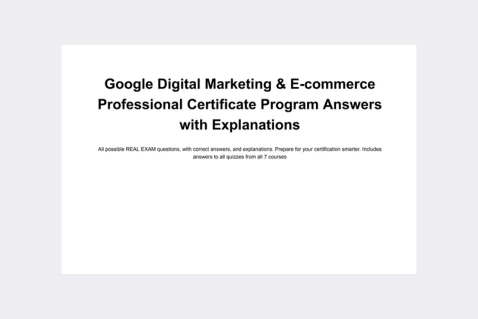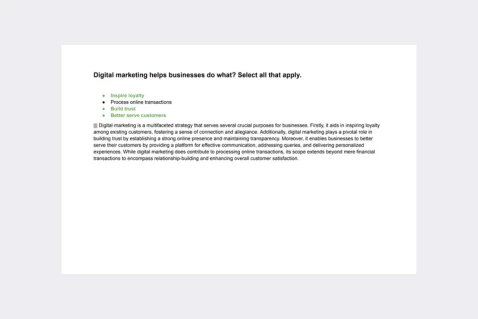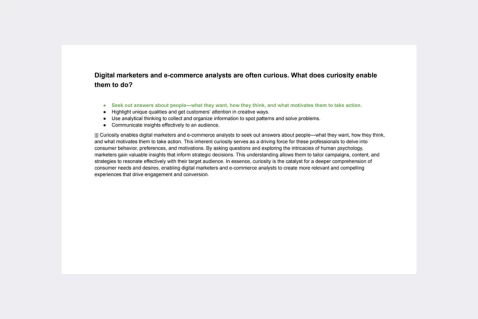Consider the following scenario: A customer makes an online purchase. First, they discover the product. Then, they find answers to their questions, decide to make the purchase, and recommend the product to others. What is the path called that the customer takes from finding the product to recommending it?
The customer journey
The company pain points
The awareness tactic
The strategic marketing plan
Certification program: 👉 Google Digital Marketing & E-commerce Professional Certificate (Coursera)
Explanation: The path that the customer takes from finding the product to recommending it is called the customer journey. The customer journey encompasses the entire process a customer goes through, from the initial discovery of a product or service to the post-purchase stages, including finding information, making a decision, and potentially becoming an advocate by recommending the product to others. This journey reflects the various touchpoints and interactions a customer has with a brand, emphasizing the importance of understanding and optimizing each stage to create a positive and seamless experience. Unlike terms such as company pain points or awareness tactics, the customer journey specifically describes the dynamic and evolving relationship between the customer and the product or service.
Passing exams is not a workout. Multiple attempts won’t make you stronger.



- All possible certificate program questions
- Real certification exam questions
- Detailed answer explanations.
- Over 1700 questions, 7 courses, 30 quizzes
- Free lifetime updates.
Understanding the Customer Journey: From Discovery to Advocacy
In the world of online commerce, understanding the customer journey is essential for businesses aiming to attract, engage, and retain customers effectively. The customer journey refers to the series of steps that a customer takes from discovering a product or service to making a purchase decision and beyond. In the scenario provided, the customer progresses through several stages, ultimately leading to recommending the product to others. But what is the specific path called that the customer takes from finding the product to recommending it?
Exploring the Customer Journey
The customer journey can be conceptualized as a series of stages that map out the path from initial awareness to advocacy. One widely used framework for understanding the customer journey is the AIDA model:
-
Awareness: The customer becomes aware of the product or service through various channels such as social media, search engines, advertising, or word-of-mouth recommendations.
-
Interest: The customer shows interest in the product or service by seeking out more information, comparing options, and evaluating how well it meets their needs or solves their problems.
-
Desire: The customer develops a desire or intention to purchase the product or service based on the perceived value, benefits, and alignment with their preferences or goals.
-
Action: The customer takes action and makes the purchase, completing the transaction either online or offline.
Identifying the Specific Path
In the scenario described, the customer progresses from discovering the product to finding answers to their questions, making the purchase decision, and ultimately recommending the product to others. This specific path aligns with the concept of the Advocacy stage of the customer journey.
Practical Insights
Here are some practical insights related to understanding and optimizing the customer journey:
-
Seamless Experience: Ensure a seamless and intuitive experience across all touchpoints of the customer journey, from initial discovery to post-purchase support. This includes optimizing your website, providing clear and concise product information, and offering responsive customer service.
-
Educational Content: Create informative and engaging content that addresses common questions, concerns, and pain points of your target audience. By providing valuable information, you can guide customers through the decision-making process and build trust and credibility.
-
Loyalty Programs: Implement loyalty programs or referral incentives to encourage repeat purchases and advocacy among satisfied customers. Rewarding customers for their loyalty and advocacy can help foster a sense of belonging and appreciation.
-
Social Proof: Leverage social proof in the form of customer reviews, testimonials, and user-generated content to build credibility and trust. Positive reviews and recommendations from existing customers can significantly influence purchase decisions and drive advocacy.
-
Continuous Engagement: Stay connected with customers even after the purchase is made. Engage with them through follow-up emails, personalized recommendations, and exclusive offers to nurture long-term relationships and encourage advocacy.
By understanding the customer journey and the specific path from discovery to advocacy, businesses can effectively tailor their marketing strategies, optimize their touchpoints, and foster long-term customer relationships.
In conclusion, while the customer journey encompasses multiple stages, the specific path described in the scenario falls under the Advocacy stage, where customers transition from making a purchase to recommending the product to others. By focusing on nurturing advocacy, businesses can harness the power of satisfied customers to drive growth and success.
Discover our best-value guides
- Special Bundle Offer Google_Ads_Roll
- Special Bundle Offer HubSpot_Exams_Roll
- Special Offer Unchained_Guru_Roll
- Special Bundle Offer Amazon_Roll
- Special Bundle Offer Google_Analytics_Roll
- Special Bundle Offer Google_SkillShop_Roll
- Special Bundle Offer Marketing_Platforms_Roll
- Special Bundle Offer Microsoft_Advertising_Roll
- Special Bundle Offer YouTube_Roll
- Special Bundle Offer Google_Android_Roll
- Ultimate PMP certification preperation guide
- Google Cloud Professional Architect Certification Exam Answers - Ultimate Guide
- Special Bundle Offer SEMrush_Roll